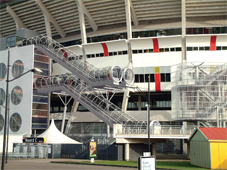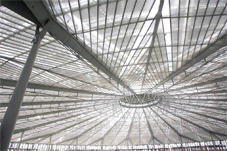
Today''s strong emp has is on environmentally responsible design and construction is just one of the many challenges facing architects and builders of residential and commercial buildings. Other mandates include durability and performance for sustained value over the long term, improved security, and greater healthfulness and comfort for people who live and work in these structures. In spite of the economic downturn, which is putting extra cost pressures on new construction, aesthetics and design innovation continue to play a major role. Engineering thermoplastics provide answers to this list of requirements, both as replacements for traditional materials and as drivers of innovation and creativity. These versatile materials offer a host of environmental advantages and can contribute significantly to system cost savings. By incorporating plastics into building components from roofing and glazing to cladding and solar systems, architects and contractors can achieve a unique combination of aesthetics, functionality and high performance. Sustainable design with less impact on the environment The field of sustainable design has arisen in response to concerns about the environmental impact of buildings and their systems throughout their lifecycles. Sustainable design aims to create healthier and more resource-efficient models of construction, renovation, operation, maintenance, and demolition. Plastics can enhance sustainable design in a variety of ways, including enhancing alternative energy use and energy conservation and the supporting recyclability. With the advent of new technologies and increases in government and private investment, alternative energy sources for homes and commercial buildings are becoming more widely used. Engineered thermoplastics support this trend by enabling improved performance of solar collectors. Lightweight plastics are replacing expensive and cumbersome metal; for example, Norway''s Solarnor AS developed a reservoir for its solar panels using a heat-resistant polymer that complies with European Union environmental guidelines. In the Netherlands, a hydroculture company has constructed greenhouses using Lexan Thermoclear* polycarbonate twin-wall roofing panels from SABIC Innovative Plastics to collect extra energy from sunlight that can be sold as surplus. The unique panels provide higher light transmission than glass, while ensuring excellent insulation properties. Another facet of sustainable design is improving the efficiency of systems utilising traditional energy sources. Specialised PC sheet that blocks infrared radiation can reduce the build-up of interior heat, leading to lower energy consumption without interfering with airy, light-filled designs. This material is an excellent choice for skylights, walkways, and roof domes where it is important to admit high light levels while reducing heat that would otherwise require air conditioning. In Amsterdam, the Arena stadium escalators are enclosed in curved, transparent Lexan* Solar Control sheet from SABIC Innovative Plastics. This material helps absorb infrared (IR) and near-IR radiation from the sun, potentially reducing interior heat buildup by up by as much as 40 percent. The tough Lexan sheet also helps protect stadium patrons from inclement weather conditions. At the end of the building material lifecycle, plastics lend themselves to recycling efforts. ArmorLite?Roofing created the first patented polymer slate, shake, and tile, which is 100 percent recyclable to reduce waste. As an added eco bonus, because polymer weighs so much less than wood, concrete, metal, and asphalt, ArmorLite roofing significantly reduces consumption of fuel required to ship the materials.

Security and protection in homes Continuing concerns about terrorism, plus new crime threats such as kidnapping, demand extra physical security for many buildin
Adidas Puma Shoes Today''s strong emp has is on environmentally responsible design and construction is just one of the many challenges facing architects and builders of residential and commercial buildings. Other mandates include durability and performance for sustained value over the long term, improved security, and greater healthfulness and comfort for people who live and work in these structures. In spite of the economic downturn, which is putting extra cost pressures on new construction, aesthetics and design innovation continue to play a major role. Engineering thermoplastics provide answers to this list of requirements, both as replacements for traditional materials and as drivers of innovation and creativity. These versatile materials offer a host of environmental advantages and can contribute significantly to system cost savings. By incorporating plastics into building components from roofing and glazing to cladding and solar systems, architects and contractors can achieve a unique combination of aesthetics, functionality and high performance. Sustainable design with less impact on the environment The field of sustainable design has arisen in response to concerns about the environmental impact of buildings and their systems throughout their lifecycles. Sustainable design aims to create healthier and more resource-efficient models of construction, renovation, operation, maintenance, and demolition. Plastics can enhance sustainable design in a variety of ways, including enhancing alternative energy use and energy conservation and the supporting recyclability. With the advent of new technologies and increases in government and private investment, alternative energy sources for homes and commercial buildings are becoming more widely used. Engineered thermoplastics support this trend by enabling improved performance of solar collectors. Lightweight plastics are replacing expensive and cumbersome metal; for example, Norway''s Solarnor AS developed a reservoir for its solar panels using a heat-resistant polymer that complies with European Union environmental guidelines. In the Netherlands, a hydroculture company has constructed greenhouses using Lexan Thermoclear* polycarbonate twin-wall roofing panels from SABIC Innovative Plastics to collect extra energy from sunlight that can be sold as surplus. The unique panels provide higher light transmission than glass, while ensuring excellent insulation properties. Another facet of sustainable design is improving the efficiency of systems utilising traditional energy sources. Specialised PC sheet that blocks infrared radiation can reduce the build-up of interior heat, leading to lower energy consumption without interfering with airy, light-filled designs. This material is an excellent choice for skylights, walkways, and roof domes where it is important to admit high light levels while reducing heat that would otherwise require air conditioning. In Amsterdam, the Arena stadium escalators are enclosed in curved, transparent Lexan* Solar Control sheet from SABIC Innovative Plastics. This material helps absorb infrared (IR) and near-IR radiation from the sun, potentially reducing interior heat buildup by up by as much as 40 percent. The tough Lexan sheet also helps protect stadium patrons from inclement weather conditions. At the end of the building material lifecycle, plastics lend themselves to recycling efforts. ArmorLite?Roofing created the first patented polymer slate, shake, and tile, which is 100 percent recyclable to reduce waste. As an added eco bonus, because polymer weighs so much less than wood, concrete, metal, and asphalt, ArmorLite roofing significantly reduces consumption of fuel required to ship the materials.
Today''s strong emp has is on environmentally responsible design and construction is just one of the many challenges facing architects and builders of residential and commercial buildings. Other mandates include durability and performance for sustained value over the long term, improved security, and greater healthfulness and comfort for people who live and work in these structures. In spite of the economic downturn, which is putting extra cost pressures on new construction, aesthetics and design innovation continue to play a major role. Engineering thermoplastics provide answers to this list of requirements, both as replacements for traditional materials and as drivers of innovation and creativity. These versatile materials offer a host of environmental advantages and can contribute significantly to system cost savings. By incorporating plastics into building components from roofing and glazing to cladding and solar systems, architects and contractors can achieve a unique combination of aesthetics, functionality and high performance. Sustainable design with less impact on the environment The field of sustainable design has arisen in response to concerns about the environmental impact of buildings and their systems throughout their lifecycles. Sustainable design aims to create healthier and more resource-efficient models of construction, renovation, operation, maintenance, and demolition. Plastics can enhance sustainable design in a variety of ways, including enhancing alternative energy use and energy conservation and the supporting recyclability. With the advent of new technologies and increases in government and private investment, alternative energy sources for homes and commercial buildings are becoming more widely used. Engineered thermoplastics support this trend by enabling improved performance of solar collectors. Lightweight plastics are replacing expensive and cumbersome metal; for example, Norway''s Solarnor AS developed a reservoir for its solar panels using a heat-resistant polymer that complies with European Union environmental guidelines. In the Netherlands, a hydroculture company has constructed greenhouses using Lexan Thermoclear* polycarbonate twin-wall roofing panels from SABIC Innovative Plastics to collect extra energy from sunlight that can be sold as surplus. The unique panels provide higher light transmission than glass, while ensuring excellent insulation properties. Another facet of sustainable design is improving the efficiency of systems utilising traditional energy sources. Specialised PC sheet that blocks infrared radiation can reduce the build-up of interior heat, leading to lower energy consumption without interfering with airy, light-filled designs. This material is an excellent choice for skylights, walkways, and roof domes where it is important to admit high light levels while reducing heat that would otherwise require air conditioning. In Amsterdam, the Arena stadium escalators are enclosed in curved, transparent Lexan* Solar Control sheet from SABIC Innovative Plastics. This material helps absorb infrared (IR) and near-IR radiation from the sun, potentially reducing interior heat buildup by up by as much as 40 percent. The tough Lexan sheet also helps protect stadium patrons from inclement weather conditions. At the end of the building material lifecycle, plastics lend themselves to recycling efforts. ArmorLite?Roofing created the first patented polymer slate, shake, and tile, which is 100 percent recyclable to reduce waste. As an added eco bonus, because polymer weighs so much less than wood, concrete, metal, and asphalt, ArmorLite roofing significantly reduces consumption of fuel required to ship the materials.  Security and protection in homes Continuing concerns about terrorism, plus new crime threats such as kidnapping, demand extra physical security for many buildinAdidas Puma Shoes
Security and protection in homes Continuing concerns about terrorism, plus new crime threats such as kidnapping, demand extra physical security for many buildinAdidas Puma Shoes













